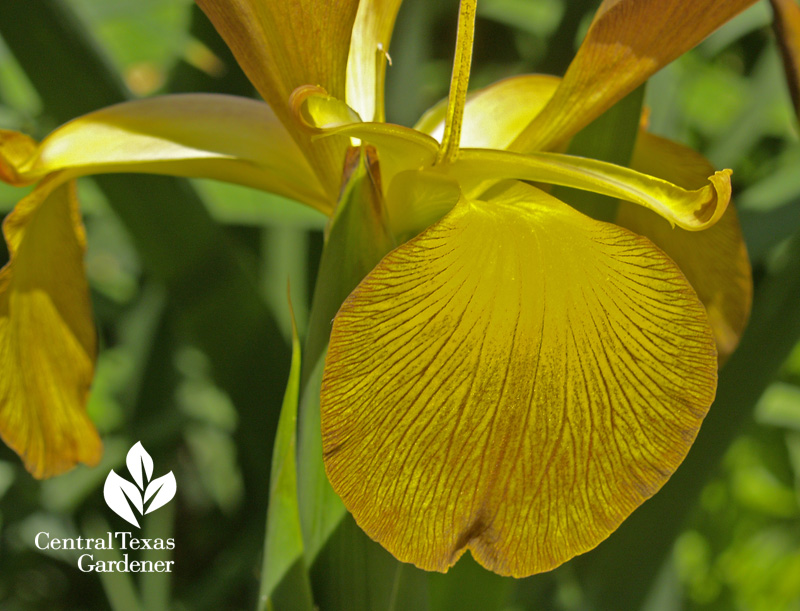April 12, 2012
Plants that survived the Texas Two-Step: Freeze and Drought

Although my spuria iris flowers astound me just once a year, they do it every year—drought, flood, or freeze—since Scott Ogden shared a few divisions with me years ago.
My garden is resilient, too, thanks to the words he’s shared with me through all his books. Lauren Springer Ogden is another mentor, through her The Undaunted Garden (recently revised with Fulcrum Publishing) for garden design, plant resumes, and the poetry of words that express our love of the garden.

Lauren and Scott collaborated on Plant-Driven Design, which ought be be in your grubby hands, if not already. Their latest (and very timely) partnership is Waterwise Plants for Sustainable Gardens, a quick-read, hands-on guide to peruse as you head to the nursery.

Icons quickly indicate each plant’s favored conditions (including deer resistance and wildlife attraction). With each featured plant, the Ogdens include other options and companions.
Wow on CTG this week when they join Tom in a passionate conversation about the plants that took the “double spanking,”—Lauren’s on-target description about last year’s extreme freeze and drought.

One they mention as a durable replacement for sago palms (cycads) is Dioon angustifolium (formerly Dioon edule var. angustifolium). That’s one on my list for this year. In the meantime, I nabbed a Dioon edule.

Another is Lady Banks rose (Rosa banksiae ‘Lutea’). Here’s mine in full bloom in the cat cove. I don’t think I’ve watered it since it was a youngster.

The Ogdens love seasonal bulbs and rhizomes as much as I do. I’ve divided the original spurias again and again to include their strappy foliage in several sections of my garden.


When they brown up in a few months, I’ll cut them back. In some areas, neighboring perennials fill out to cover the spot or I’ll seed annuals.
Here’s a great example to illustrate the tenacity of Lady Banks. Years ago, I planted the fragrant white one ‘Alba Plena’ (included in Waterwise) at the back fence. Primrose jasmine grew up to smother it. No irrigation, fertilizer, or even attention until it sent its light-deprived stems into the trees to bloom.
In our recent project, when I dug out the primrose jasmines, I discovered that she was still there and had even rooted a second one.

A few weeks after I began its renovation, it had already filled out and bloomed. White Lady Banks is sweetly fragrant.

I’ll keep working to promote her renewed form, but I suspect she’ll cover that fence by summer’s end! I’m training some long stems to cover that back fence, too.

In Waterwise, the Ogdens include various Jerusalem sages (Phlomis). This P. fruticosa is blooming like crazy in a hot median strip at Mueller.

I spotted this lush display, accompanied by pink skullcap, in an east Austin garden.

I’m treasuring my P. lanata, a dwarf form, that fits so well into one of my front beds.

That bed includes another Ogden inspiration, a Yucca recurvifolia ‘Margaritaville’. I saw it in one of their books and nabbed one for myself.

Although some things in this bed are new from last fall, many others have made it through the Texas Two-Step for several years.
Jerusalem sage is one that Merrideth Jiles includes in his Backyard Basics list of “double spanking” plants that made it in his east Austin garden. Get his list here.

Among his success stories: Olive tree (Olea europea). Since 2006, this one’s been growing in the garden of my friends, Molly and David.

They also have a fine-looking sotol (Dasylirion wheeleri), another that Merrideth and the Ogdens include on their lists.

Certain species of sedges (Carex) make the list for Merrideth, the Ogdens, and me. I’ve bought it as Texas sedge (Carex texensis)/Carex retroflexa var. texensis/Scott’s Turf.

Merrideth explains how to add Globe mallow (Sphaeralcea ambigua), another double trouble star. A few months ago, I finally got one when I dug out dead grass and had a good sunny spot for it. Obviously, I got this picture on one of our luscious cloudy days!

Texas mountain laurel, Daphne’s Pick of the Week, favored us this year with outstanding performance, a keeper for double troubled Texas gardens.
But every year, viewers ask us why theirs didn’t bloom. There are many factors, but one is by pruning off the flower buds that form almost immediately after bloom.

You also need to watch out for the Genista caterpillar, which can defoliate a tree while you’re at the grocery store. Hand-pick or spray Bt (Bacillus thuringiensis) to spare the ravage.

On tour, see how Anne Bellomy replaced lawn and invasive plants with waterwise specimens that have turned her formerly wildlife-bereft lot into a garden for resident and migratory wildlife.
Now, what about those exposed oak tree roots?

A viewer asked if she can plant groundcover (like sedges!) in between, and how much soil can she add. Get Daphne’s answer.
See you next week! Linda
tags:

